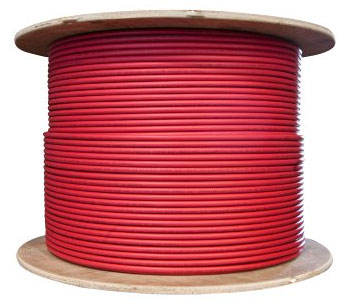
The intricate networks that power our world, from small gadgets to large industrial machinery, depend significantly on a diverse range of wires and cables. Designers create each wire and cable type with specific applications in mind, incorporating features that make them suitable for those particular scenarios. In this guide, we’ll delve into some commonly used wires and cables, spotlighting their industrial applications and distinguishing features.
PV Wire (Photovoltaic Wire)
PV wire is explicitly designed for solar panel applications, connecting individual solar panels and leading to the solar inverter. With a sturdy build, it can withstand direct sunlight and harsh environmental conditions, making it perfect for outdoor solar installations. Its UV-resistance and flexibility make it the go-to choice for solar energy systems.
Bare Copper
Often found grounding electrical systems, bare copper wires play a critical role in ensuring the safety of various electrical applications. Given its high conductivity, it effectively carries electrical current away in case of any electrical faults, minimizing the risk of electrical shocks or fires. Industries with high-power machinery frequently deploy bare copper for grounding purposes.
Battery Cable
As the name suggests, battery cables are designed to connect batteries to other components. Their thick build and high conductivity make them perfect for transmitting high amounts of power. You’ll often find these cables in automotive industries, connecting car batteries to engines or in backup power systems.
Communication Cables
In our digital age, communication cables are ubiquitous, linking data networks and telecommunication systems. People use these cables, including CAT 5 or CAT 6, in server rooms, IT hubs, and telecommunication setups, enabling swift and clear data transmission.
Tray Cables
Tray cables, designed for versatility, find utility in various settings, including power, control, and communication applications. Their design permits their use in trays, conduits, or even direct burial.Industrial plants often use tray cables for machinery controls, given their adaptability and resilience.
USE-2 Wire
People commonly employ Underground Service Entrance (USE-2) wires to transmit power from overhead lines to homes or businesses. With a sturdy design that’s resistant to moisture and heat, they’re suitable for direct burial underground. Their primary application is in power distribution networks.
Conclusion: Decoding the Right Wire for Your Needs
Understanding the distinct features and applications of each wire and cable type is essential for optimal performance and safety. Whether it’s harnessing the power of the sun, grounding an industrial setup, or facilitating smooth communication, each wire and cable serves a unique purpose. When selecting, always consider the specific requirements of your project, ensuring that the chosen wire or cable not only fits the purpose but also adheres to industry standards and safety norms.

